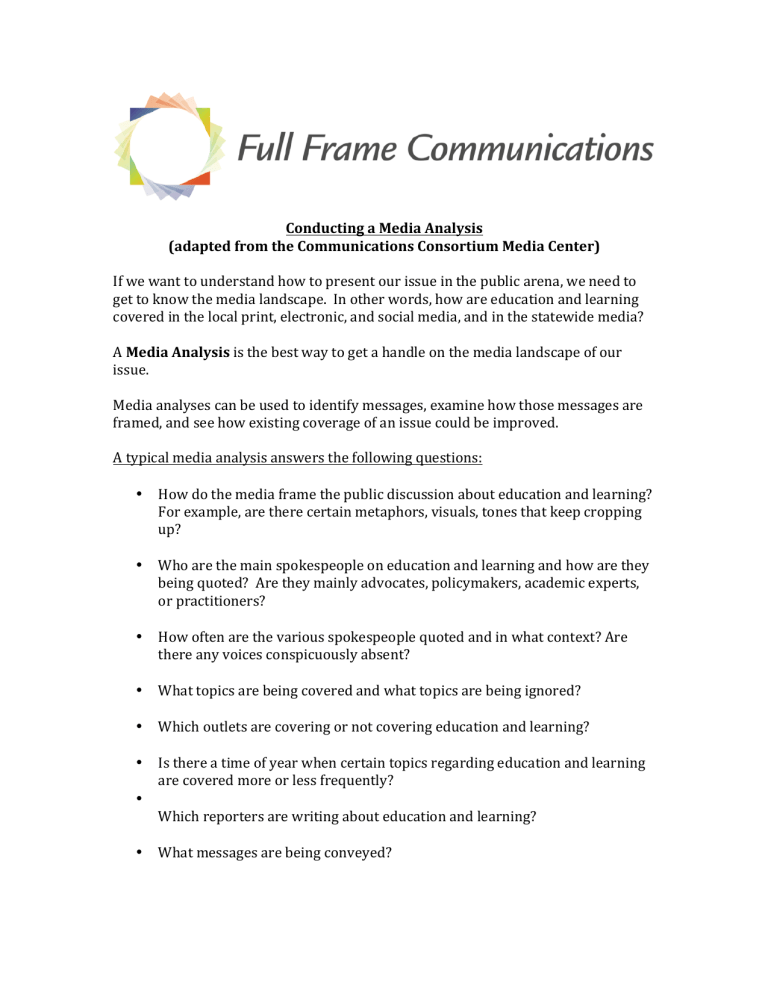
Conducting a Media Analysis (adapted from the Communications Consortium Media Center) If we want to understand how to present our issue in the public arena, we need to get to know the media landscape. In other words, how are education and learning covered in the local print, electronic, and social media, and in the statewide media? A Media Analysis is the best way to get a handle on the media landscape of our issue. Media analyses can be used to identify messages, examine how those messages are framed, and see how existing coverage of an issue could be improved. A typical media analysis answers the following questions: • How do the media frame the public discussion about education and learning? For example, are there certain metaphors, visuals, tones that keep cropping up? • Who are the main spokespeople on education and learning and how are they being quoted? Are they mainly advocates, policymakers, academic experts, or practitioners? • How often are the various spokespeople quoted and in what context? Are there any voices conspicuously absent? • What topics are being covered and what topics are being ignored? • Which outlets are covering or not covering education and learning? • Is there a time of year when certain topics regarding education and learning are covered more or less frequently? • Which reporters are writing about education and learning? • What messages are being conveyed? Here are the basic steps for conducting a media analysis: 1) Make a list of all the different media outlets in your community and the surrounding area, just so you have a handle on the landscape. 2) Make a second list of statewide media. 3) Develop a set of search terms. In this case, you will likely want to include some of the following: education, learning, Act 77, school reform, education reform, high school redesign, Agency of Education. This is not an exhaustive list; if there are particular issues in your community related to education, please include the relevant search terms in your list. 4) Using Google, Google News, and or the media outlet’s search or archive function, collect a “slice” of media coverage over a set time frame, in this case, the last six months. A typical, professionally prepared media analysis typically includes between 100-­‐200 stories. Don’t worry: you will be collecting only a dozen or so samples! Remember to include newspapers, magazines, and electronic and digital media (radio, TV, social media). Focus primarily on coverage in your own community, but pay some attention to the statewide media landscape, e.g., VPR, the Burlington Free Press, Seven Days, and other outlets in the larger cities and towns in Vermont. 5) Once you’ve drawn the sample, read and categorize the stories. In traditional media, opinion, news and feature stories are the three primary categories you’ll encounter. Facebook and other social media are also becoming important sources for media analyses. 6) You may get some irrelevant articles such as calendar items and obituaries. Be sure to eliminate those to come up with a list of stories that have substance. 7) Analyze what you have in front of you. Which outlet or source does the piece come from? Where is it placed, e.g., on a front or home page, in the back pages, at the beginning or end of a newscast? How much time/space is allotted to the topic? What time of year did the story run and is that significant? Who is covering these issues (you can include bloggers)? Please refer back to the questions at the top of this document. Some people like to make a spreadsheet of all of this information so they can keep track of it all. 8) Write a short summary of what you have learned from this exercise. Be sure to address this question: Now that you have scanned the media landscape, what are your thoughts about the opportunities you have to introduce our well-­‐framed public story into the public conversation?

